Amber: Difference between revisions
| Line 136: | Line 136: | ||
Amber has been used since the stone age, from 13,000 years ago.<ref name=Grimaldi2009/> Amber ornaments have been found in [[Mycenae]]an tombs and elsewhere across Europe.{{Citation needed|date=August 2010}} To this day it is used in the manufacture of smoking and glassblowing mouthpieces.<ref>{{cite web|url=http://www.pipesandtobaccos.com/pipesandtobaccos/info/insights/baldoview.htm |title=Interview with expert pipe maker, Baldo Baldi . Accessed 10-12-09 |publisher=Pipesandtobaccos.com |date=2000-02-11 |accessdate=2010-07-30}}</ref><ref>{{cite web|url=http://steinertindustries.com/osc/advanced_search_result.php?search_in_description=1&keywords=amber&osCsid=d8f7cf307cfb59b1356aa7e3abfaa59e |title=Maker of amber mouthpiece for glass blowing pipes. Accessed 10-12-09 |publisher=Steinertindustries.com |date=2007-05-07 |accessdate=2010-07-30}}</ref> Amber's place in culture and tradition lends it a tourism value; [[Palanga Amber Museum]] is dedicated to the mineral. |
Amber has been used since the stone age, from 13,000 years ago.<ref name=Grimaldi2009/> Amber ornaments have been found in [[Mycenae]]an tombs and elsewhere across Europe.{{Citation needed|date=August 2010}} To this day it is used in the manufacture of smoking and glassblowing mouthpieces.<ref>{{cite web|url=http://www.pipesandtobaccos.com/pipesandtobaccos/info/insights/baldoview.htm |title=Interview with expert pipe maker, Baldo Baldi . Accessed 10-12-09 |publisher=Pipesandtobaccos.com |date=2000-02-11 |accessdate=2010-07-30}}</ref><ref>{{cite web|url=http://steinertindustries.com/osc/advanced_search_result.php?search_in_description=1&keywords=amber&osCsid=d8f7cf307cfb59b1356aa7e3abfaa59e |title=Maker of amber mouthpiece for glass blowing pipes. Accessed 10-12-09 |publisher=Steinertindustries.com |date=2007-05-07 |accessdate=2010-07-30}}</ref> Amber's place in culture and tradition lends it a tourism value; [[Palanga Amber Museum]] is dedicated to the mineral. |
||
[[File:Colar de Ambar Fio.jpg|thumb|Amber jewellery from [[Dominican Republic]]]] |
[[File:Colar de Ambar Fio.jpg|thumb|Amber jewellery from [[Dominican Republic]]]] |
||
Almost the largest Baltic amber online store [http://www.ambrestone.com www.ambrestone.com] . It sells only quality products. Their activities they engaged in more than 20 years. |
|||
[[File: amber.jpg]] |
|||
===Historic medicinal uses=== |
===Historic medicinal uses=== |
||
Revision as of 14:52, 27 July 2012
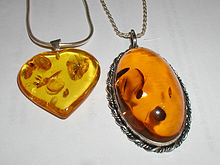
| Part of a series on |
| Paleontology |
|---|
 |
|
Paleontology Portal Category |
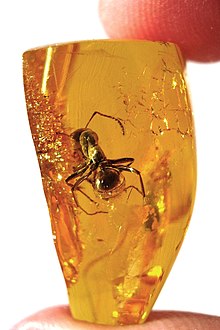
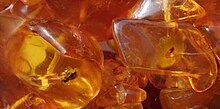



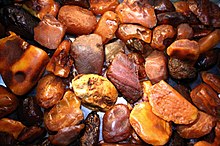
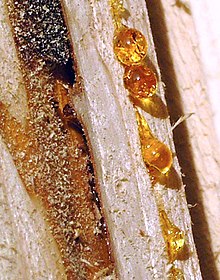


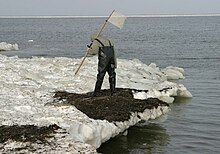
Amber is fossilized tree resin (not sap), which has been appreciated for its color and natural beauty since Neolithic times.[2] Amber is used as an ingredient in perfumes, as a healing agent in folk medicine, and as jewelry. There are five classes of amber, defined on the basis of their chemical constituents. Because it originates as a soft, sticky tree resin, amber sometimes contains animal and plant material as inclusions. Amber occurring in coal seams is also called resinite, and the term ambrite is applied to that found specifically within New Zealand coal seams.[3]
History and etymology
The English word amber derives from the Arabic anbar, via Medieval Latin ambar and Old French ambre. The word originally referred to a solid waxy substance derived from the sperm whale (now called ambergris). The sense was extended to fossil resin circa 1400, and this became the main sense, as the use of ambergris waned.[4] The two substances were confused, because they both were found washed up on beaches. Ambergris is less dense than water and floats, whereas amber is less dense than stone, but too dense to float.[5] The word ambar was brought to Europe by the Crusaders. In French ambre gris (lit. gray amber), became used for ambergris, while ambre jaune (yellow amber), denoted the fossil resin we now call amber.
Amber is discussed by Theophrastus, possibly the first historical mention of the material, in the 4th century BC. The Greek name for amber was ἤλεκτρον (elektron), "formed by the sun", and it was connected to the sun god (Helios), one of whose titles was Elector or the Awakener.[6] According to the myth, when Helios' son Phaëton was killed, his mourning sisters became poplars, and their tears became the origin of elektron, amber.[7]
Another early reference to Amber was Pytheas (330 BC) whose work "On the Ocean" is lost, but was referenced by Pliny. According to The Natural History" by Pliny the Elder:[8]
Pytheas says that the Gutones, a people of Germany, inhabit the shores of an estuary of the Ocean called Mentonomon, their territory extending a distance of six thousand stadia; that, at one day's sail from this territory, is the Isle of Abalus, upon the shores of which, amber is thrown up by the waves in spring, it being an excretion of the sea in a concrete form; as, also, that the inhabitants use this amber by way of fuel, and sell it to their neighbors, the Teutones.
While amber is not actually named, it is called the concreti maris purgamentum, "the leavings of the frozen sea" after the spring melt. Diodorus uses ēlektron, the Greek word for amber, the object that gave its name to electricity through its ability to acquire a charge. Pliny is presenting an archaic view, as in his time amber was a precious stone brought from the Baltic at great expense, but the Germans, he says, use it for firewood, according to Pytheas.
Earlier[9] Pliny says that a large island of three days' sail from the Scythian coast called Balcia by Xenophon of Lampsacus is called Basilia by Pytheas. It is generally understood to be the same as Abalus. Based on the amber, the island could have been Heligoland, Zealand, the shores of Bay of Gdansk, Sambia or the Curonian Lagoon, which were historically the richest sources of amber in northern Europe. This is the earliest use of Germania.
The modern terms "electricity" and "electron" derive from the Greek word for amber, and come from William Gilbert's research showing that amber could attract other substances.[10] The word "electron" was coined in 1891 by the Irish physicist George Stoney whilst analyzing elementary charges for the first time.[11][12]
The presence of insects in amber was noticed by Pliny the Elder in his Naturalis Historia, and led him to theorize correctly that, at some point, amber had to be in a liquid state to cover the bodies of insects. Hence he gave it the expressive name of succinum or gum-stone, a name that is still in use today to describe succinic acid as well as succinite, a term given to a particular type of amber by James Dwight Dana (see below under Baltic Amber).
Heating amber will soften it and eventually it will burn, which is why in some Germanic languages the word for amber is a literal translation of burn-stone (nl. barnsteen, de. Bernstein, the latter of which the Polish word bursztyn or the Hungarian borostyán derives from). Heated above 200 °C, amber suffers decomposition, yielding an "oil of amber", and leaving a black residue which is known as "amber colophony", or "amber pitch"; when dissolved in oil of turpentine or in linseed oil this forms "amber varnish" or "amber lac". [citation needed]
Amber from the Baltic Sea has been extensively traded along the Amber Road since antiquity; and in the mainland, from where amber was traded 2000 years ago, the natives called it glaes (referring to its see-through quality similar to glass). [citation needed]
The Baltic Lithuanian term for amber is Gintaras and Latvian Dzintars. They, and the Slavic jantar or Hungarian gyanta ('resin'), are thought to originate from Phoenician jainitar (sea-resin). While most Slavic languages, including Russian and Czech, retain the old Slavic word, in the Polish and Belarusian languages, jantar, while correct, is used very rarely (even considered archaic) and was replaced by the word bursztyn, deriving from the German term, Bernstein.[citation needed]
Composition and formation
This section may be too technical for most readers to understand. (July 2012) |
Amber is heterogeneous in composition, but consists of several resinous bodies more or less soluble in alcohol, ether and chloroform, associated with an insoluble bituminous substance. Amber is a macromolecule by free radical polymerization of several precursors in the labdane family, e.g. communic acid, cummunol, and biformene.[13] These labdanes are diterpenes (C20H32) and trienes, equipping the organic skeleton with three alkene groups for polymerization. As amber matures over the years, more polymerization takes place as well as isomerization reactions, crosslinking and cyclization.
The average composition of amber leads to the general formula C10H16O.
Formation
Molecular polymerization, resulting from high pressures and temperatures produced by overlying sediment, transforms the resin first into copal. Sustained heat and pressure drives off terpenes and results in the formation of amber.[14]
Botanical origin
Fossil resins from Europe fall into two categories, the famous Baltic ambers and another that resembles the Agathis group. Fossil resins from the Americas and Africa are closely related to the modern genus Hymenaea,[15] while Baltic ambers are thought to be fossil resins from Sciadopityaceae family plants that used to live in north Europe.[16]
Inclusions
The abnormal development of resin has been called succinosis. Impurities are quite often present, especially when the resin dropped on to the ground, so that the material may be useless except for varnish-making, whence the impure amber is called firniss. Enclosures of pyrites may give a bluish color to amber. The so-called black amber is only a kind of jet. Bony amber owes its cloudy opacity to minute bubbles in the interior of the resin.
In darkly clouded and even opaque amber, inclusions can be imaged using high-energy, high-contrast, high-resolution X-rays.[17]
Extraction and processing
Distribution and mining
Amber is globally distributed, mainly in rocks of Cretaceous age or younger. Historically, the coast around Königsberg in Prussia was the world's leading source of amber. About 90% of the world's extractable amber is still located in the Kaliningrad Oblast of Russia on the Baltic Sea (which was previously Königsberg in Prussia, before World War II).[18]
Pieces of amber torn from the seafloor are cast up by the waves, and collected by hand, dredging, or diving. Elsewhere, amber is mined, both in open works and underground galleries. Then nodules of blue earth have to be removed and an opaque crust must be cleaned off, which can be done in revolving barrels containing sand and water. Erosion removes this crust from sea-worn amber.
Dominican amber, especially Dominican blue amber, is mined through bell pitting, which is dangerous due to the risk of tunnel collapse.[19]
Treatment
The Vienna amber factories, which use pale amber to manufacture pipes and other smoking tools, turn it on a lathe and polish it with whitening and water or with rotten stone and oil. The final lustre is given by friction with flannel.
When gradually heated in an oil-bath, amber becomes soft and flexible. Two pieces of amber may be united by smearing the surfaces with linseed oil, heating them, and then pressing them together while hot. Cloudy amber may be clarified in an oil-bath, as the oil fills the numerous pores to which the turbidity is due. Small fragments, formerly thrown away or used only for varnish, are now used on a large scale in the formation of "amberoid" or "pressed amber". The pieces are carefully heated with exclusion of air and then compressed into a uniform mass by intense hydraulic pressure; the softened amber being forced through holes in a metal plate. The product is extensively used for the production of cheap jewelry and articles for smoking. This pressed amber yields brilliant interference colors in polarized light. Amber has often been imitated by other resins like copal and kauri, as well as by celluloid and even glass. Baltic amber is sometimes colored artificially, but also called "true amber".
Appearance
Amber occurs in a range of different colors. As well as the usual yellow-orange-brown that is associated with the color "amber", amber itself can range from a whitish color through a pale lemon yellow, to brown and almost black. Other more uncommon colors include red amber (sometimes known as "cherry amber"), green amber, and even blue amber, which is rare and highly sought after.
Much of the most highly prized amber is transparent, in contrast to the very common cloudy amber and opaque amber. Opaque amber contains numerous minute bubbles. This kind of amber is known as "bony amber".
Although all Dominican amber is fluorescent, the rarest Dominican amber is blue amber. It turns blue in natural sunlight and any other partially or wholly ultraviolet light source. In long-wave UV light it has a very strong reflection, almost white. Only about 100 kg is found per year, which makes it valuable and expensive.[20]
Sometimes amber retains the form of drops and stalactites, just as it exuded from the ducts and receptacles of the injured trees. It is thought that, in addition to exuding onto the surface of the tree, amber resin also originally flowed into hollow cavities or cracks within trees, thereby leading to the development of large lumps of amber of irregular form.
Classification
Amber can be classified into several forms. Most fundamentally, there are two types of plant resin with the potential for fossilization. Terpenoids, produced by conifers and angiosperms, consist of ring structures formed of isoprene (C5H8) units.[2] Phenolic resins are today only produced by angiosperms, and tend to serve functional uses. The extinct medullosans produced a third type of resin, which is often found as amber within their veins.[2] The composition of resins is highly variable; each species produces a unique blend of chemicals which can be identified by the use of pyrolysis–gas chromatography–mass spectrometry.[2] The overall chemical and structural composition is used to divide ambers into five classes.[21][22] There is also a separate classifications of amber gemstones, according to the way of production.
Class I
This class is by far the most abundant. It comprises labdatriene carboxylic acids such as communic or ozic acids.[21] It is further split into three sub-classes. Classes Ia and Ib utilise regular labdanoid diterpenes (e.g. communic acid, communol, biformenes), whilst Ic uses enantio labdanoids (ozic acid, ozol, enantio biformenes).[23]
Ia
Includes Succinite (= 'normal' Baltic amber) and Glessite.[22] Have a communic acid base. They also include much succinic acid.[21]
Baltic amber yields on dry distillation succinic acid, the proportion varying from about 3% to 8%, and being greatest in the pale opaque or bony varieties. The aromatic and irritating fumes emitted by burning amber are mainly due to this acid. Baltic amber is distinguished by its yield of succinic acid, hence the name succinite. Succinite has a hardness between 2 and 3, which is rather greater than that of many other fossil resins. Its specific gravity varies from 1.05 to 1.10.[24] It can be distinguished from other ambers via IR spectroscopy due to a specific carbonyl absorption peak. IR spectroscopy can detect the relative age of an amber sample.[verification needed] Succinic acid may not be an original component of amber, but rather a degradation product of abietic acid.[25]
Ib
Like class Ia ambers, these are based on communic acid; however, they lack succinic acid.[21]
Ic
This class is mainly based on enantio-labdatrienonic acids, such as ozic and zanzibaric acids.[21] Its most familiar representative is Dominican amber.[2]
Dominican amber differentiates itself from Baltic amber by being mostly transparent and often containing a higher number of fossil inclusions. This has enabled the detailed reconstruction of the ecosystem of a long-vanished tropical forest.[26] Resin from the extinct species Hymenaea protera is the source of Dominican amber and probably of most amber found in the tropics. It is not "succinite" but "retinite".[27]
Class II
These ambers are formed from resins with a sesquiterpenoid base, such as cadinene.[21]
Class III
These ambers are polystyrenes.[21]
Class IV
This class is something of a wastebasket; its ambers are not polymerized, but mainly consist of cedrane-based sesquiterpenoids.[21]
Class V
Class V resins are considered to be produced by a pine or pine relative. They comprise a mixture of diterpinoid resins and n-alkyl compounds. Their type mineral is highgate copalite.[22]
Classification of Baltic amber (succinite) gemstones by the International Amber Association

- Natural Baltic amber – gemstone which has undergone mechanical treatment only (for instance: grinding, cutting, turning or polishing) without any change to its natural properties
- Modified Baltic amber – gemstone subjected only to thermal or high-pressure treatment, which changed its physical properties, including the degree of transparency and color, or shaped under similar conditions out of one nugget, previously cut to the required size.
- Reconstructed (pressed) Baltic amber – gemstone made of Baltic amber pieces pressed in high temperature and under high pressure without additional components.
- Bonded Baltic amber – gemstone consisting of two or more parts of natural, modified or reconstructed Baltic amber bonded together with the use of the smallest possible amount of a colorless binding agent necessary to join the pieces.
Geological record
The oldest amber recovered dates to the Upper Carboniferous period (320 million years ago).[2][28] Its chemical composition makes it difficult to match the amber to its producers – it is most similar to the resins produced by flowering plants; however, there are no flowering plant fossils until the Cretaceous, and they were not common until the Upper Cretaceous. Amber becomes abundant long after the Carboniferous, in the Early Cretaceous, 150 million years ago,[2] when it is found in association with insects. The oldest amber with arthropod inclusions comes from the MLevant, from Lebanon and Jordan. This amber, roughly 125–135 million years old, is considered of high scientific value, providing some of the oldest sampled ecosystem.[29] In Lebanon more than 450 outcrops of Lower Cretaceous amber were discovered between the 1960s and 1990s, among which about 20 outcrops have yielded biological inclusions comprising the oldest representatives of several recent families of terrestrial arthropods. Even older, Jurassic amber has been found recently in Lebanon as well. Many remarkable insects and spiders were recently discovered in the amber of Jordan including the oldest zorapterans, clerid beetles, umenocoleid roaches, and achiliid planthoppers.[29]
Baltic amber or succinite (historically documented as Prussian amber[24]) is found as irregular nodules in marine glauconitic sand, known as blue earth, occurring in the Lower Oligocene strata of Sambia in Prussia (in historical sources also referred to as Glaesaria). After 1945 this territory around Königsberg was turned into Kaliningrad Oblast, Russia, where amber is now systematically mined.[30] It appears, however, to have been partly derived from older Eocene deposits and it occurs also as a derivative phase in later formations, such as glacial drift. Relics of an abundant flora occur as inclusions trapped within the amber while the resin was yet fresh, suggesting relations with the flora of Eastern Asia and the southern part of North America. Heinrich Göppert named the common amber-yielding pine of the Baltic forests Pinites succiniter, but as the wood does not seem to differ from that of the existing genus it has been also called Pinus succinifera. It is improbable, however, that the production of amber was limited to a single species; and indeed a large number of conifers belonging to different genera are represented in the amber-flora.
Paleontological significance
Amber is a unique preservational mode, preserving otherwise unfossilizable parts of organisms; as such it is helpful in the reconstruction of ecosystems as well as organisms;[31] the chemical composition of the resin, however, is of limited utility in reconstructing the phylogenetic affinity of the resin producer.[2]
Amber sometimes contains animals or plant matter that became caught in the resin as it was secreted. Insects, spiders and even their webs, annelids, frogs,[32] crustaceans, bacteria and amoebae,[33] marine microfossils,[34] wood, flowers and fruit, hair, feathers and other small organisms have been recovered in ambers dating to 130 million years ago.[2]
Use
Amber has been used since antiquity in the manufacture of jewelry and ornaments, and also in folk medicine. Amber also forms the flavoring for akvavit liquor. Amber has been used as an ingredient in perfumes.
Jewelry
Amber has been used since the stone age, from 13,000 years ago.[2] Amber ornaments have been found in Mycenaean tombs and elsewhere across Europe.[citation needed] To this day it is used in the manufacture of smoking and glassblowing mouthpieces.[35][36] Amber's place in culture and tradition lends it a tourism value; Palanga Amber Museum is dedicated to the mineral.
Almost the largest Baltic amber online store www.ambrestone.com . It sells only quality products. Their activities they engaged in more than 20 years.
Historic medicinal uses
Amber has long been used in folk medicine for its purported healing properties. Amber and extracts were used from the time of Hippocrates in ancient Greece for a wide variety of treatments through the Middle Ages and up until the early twentieth century.[citation needed]
Scent of amber and amber perfumery
In ancient China it was customary to burn amber during large festivities. If amber is heated under the right conditions, oil of amber is produced, and in past times this was combined carefully with nitric acid to create "artificial musk" – a resin with a peculiar musky odor.[37] Although when burned, amber does give off a characteristic "pinewood" fragrance, modern products, such as perfume, do not normally use actual amber. This is due to the fact that fossilized amber produces very little scent. In perfumery, scents referred to as “amber” are often created and patented[38][39] to emulate the opulent golden warmth of the fossil.[40] The modern name for amber is thought to come from the Arabic word, ambar, meaning ambergris.[11] Ambergris is the waxy aromatic substance created in the intestines of sperm whales and was used in making perfumes both in ancient times as well as modern. The scent of amber was originally derived from emulating the scent of ambergris and/or labdanum but due to the endangered status of the sperm whale the scent of amber is now largely derived from labdanum.[41] The term “amber” is loosely used to describe a scent that is warm, musky, rich and honey-like, and also somewhat oriental and earthy. It can be synthetically created or derived from natural resins. When derived from natural resins it is most often created out of labdanum. Benzoin is usually part of the recipe. Vanilla and cloves are sometimes used to enhance the aroma.
"Amber" perfumes may be created using combinations of labdanum, benzoin resin, copal (itself a type of tree resin used in incense manufacture), vanilla, Dammara resin and/or synthetic materials.[37]
See also
References
- ^ Jessamyn Reeves-Brown (November 1997). "Mastering New Materials: Commissioning an Amber Bow, no.65". Strings magazine. Retrieved 2007-04-09.
- ^ a b c d e f g h i j Grimaldi, D. (2009). "Pushing Back Amber Production". Science. 326 (5949): 51. Bibcode:2009Sci...326...51G. doi:10.1126/science.1179328. PMID 19797645.
{{cite journal}}: More than one of|pages=and|page=specified (help) - ^ Poinar GO, Poinar R. The quest for life in amber. Basic Books, 1995, ISBN 0-201-48928-7, p. 133
- ^ Harper, Douglas. "amber". Online Etymology Dictionary.
- ^ see: Abu Zaid al Hassan from Siraf & Sulaiman the Merchant (851), Silsilat-al-Tawarikh (travels in Asia).
- ^ King, Rev. C.W. (1867). The Natural History of Gems or Decorative Stones. Cambridge (UK). p. 315.
- ^ Michael R. Collings, Gemlore: An Introduction to Precious and Semi-Precious Stones, 2009, p. 20
- ^ Natural History Book 37, Chapter 11.
- ^ Natural History IV.27.13 or IV.13.95 in the Loeb edition.
- ^ Heilbron, J.L. (1979). Electricity in the 17th and 18th Centuries: A Study of Early Modern Physics. University of California Press. p. 169. ISBN 978-0-520-03478-5.
- ^ a b Susie Ward Aber. "Welcome to the World of Amber". Emporia State University. Archived from the original on 28 April 2007. Retrieved 2007-05-11.
{{cite web}}: Unknown parameter|deadurl=ignored (|url-status=suggested) (help) - ^ "Origin of word Electron". Patent-invent.com. Retrieved 2010-07-30.
- ^ Manuel Villanueva-García, Antonio Martínez-Richa, and Juvencio Robles Assignment of vibrational spectra of labdatriene derivatives and ambers: A combined experimental and density functional theoretical study Arkivoc (EJ-1567C) pp. 449–458
- ^ Rice, Patty C. (2006). Amber: Golden Gem of the Ages. 4th Ed. AuthorHouse. ISBN 1-4259-3849-3.
- ^ Lambert, JB; Poinar Jr, GO (2002). "Amber: the organic gemstone". Accounts of chemical research. 35 (8): 628–36. doi:10.1021/ar0001970. PMID 12186567.
- ^ Wolfe, A. P. (30 June 2009). "A new proposal concerning the botanical origin of Baltic amber". Proceedings of the Royal Society B: Biological Sciences. 276 (1672): 3403–3412. doi:10.1098/rspb.2009.0806. PMC 2817186. PMID 19570786.
{{cite journal}}: Unknown parameter|coauthors=ignored (|author=suggested) (help) - ^ Amos, Jonathan (2008-04-01). "BBC News, " Secret 'dino bugs' revealed", 1 April 2008". BBC News. Archived from the original on 28 August 2010. Retrieved 2010-07-30.
{{cite news}}: Unknown parameter|deadurl=ignored (|url-status=suggested) (help) - ^ Amber Trade and the Environment in the Kaliningrad Oblast
- ^ Wilfred Wichard und Wolfgang Weitschat: Im Bernsteinwald. – Gerstenberg Verlag, Hildesheim, 2004, ISBN 3-8067-2551-9
- ^ Manuel A. Iturralde-Vennet (2001). "Geology of the Amber-Bearing Deposits of the Greater Antilles" (PDF). Caribbean Journal of Science. 37 (3): 141–167.
- ^ a b c d e f g h Anderson, K; Winans, R; Botto, R (1992). "The nature and fate of natural resins in the geosphere—II. Identification, classification and nomenclature of resinites☆". Organic Geochemistry. 18 (6): 829–841. doi:10.1016/0146-6380(92)90051-X.
- ^ a b c Anderson, K; Botto, R (1993). "The nature and fate of natural resins in the geosphere—III. Re-evaluation of the structure and composition of Highgate Copalite and Glessite". Organic Geochemistry. 20 (7): 1027. doi:10.1016/0146-6380(93)90111-N.
- ^ Anderson, Ken B. (1996). "Amber, Resinite, and Fossil Resins". ACS Symposium Series. 617: 105–129. doi:10.1021/bk-1995-0617.ch006. ISBN 0-8412-3336-5.
{{cite journal}}:|chapter=ignored (help); Cite journal requires|journal=(help) - ^ a b Chisholm 1911.
- ^ "(Rottlaender, 1970)" (PDF). Retrieved 2010-07-30.
- ^ George Poinar, Jr. and Roberta Poinar, 1999. The Amber Forest: A Reconstruction of a Vanished World, (Princeton University Press) ISBN 0-691-02888-5
- ^ Grimaldi, D. A.: Amber – Window to the Past. – American Museum of Natural History, New York 1996
- ^ Bray, P. S.; Anderson, K. B. (2009). "Identification of Carboniferous (320 Million Years Old) Class Ic Amber". Science. 326 (5949): 132–134. Bibcode:2009Sci...326..132B. doi:10.1126/science.1177539. PMID 19797659.
- ^ a b Poinar, P.O., Jr., and R.K. Milki (2001) Lebanese Amber: The Oldest Insect Ecosystem in Fossilized Resin. Oregon State University Press, Corvallis. 96 pp. ISBN 0-87071-533-X.
- ^ Langenheim, Jean (2003). Plant Resins: Chemistry, Evolution, Ecology, and Ethnobotany. Timber Press Inc. ISBN 0-88192-574-8.
- ^ BBC – Radio 4 – Amber. Db.bbc.co.uk. Retrieved on 2011-04-23.
- ^ "Scientist: Frog could be 25 million years old". MSNBC. 2007-02-16. Retrieved 2010-07-30.
- ^ Benjamin M. Waggoner (July 13, 1996). "Bacteria and protists from Middle Cretaceous amber of Ellsworth County, Kansas". PaleoBios. 17 (1): 20–26.
- ^ Attention: This template ({{cite pmid}}) is deprecated. To cite the publication identified by PMID 18981417 , please use {{cite journal}} with
|pmid=18981417instead. - ^ "Interview with expert pipe maker, Baldo Baldi . Accessed 10-12-09". Pipesandtobaccos.com. 2000-02-11. Retrieved 2010-07-30.
- ^ "Maker of amber mouthpiece for glass blowing pipes. Accessed 10-12-09". Steinertindustries.com. 2007-05-07. Retrieved 2010-07-30.
- ^ a b Amber as an aphrodisiac
- ^ Saturated indane derivatives and processes for producing same, Ernst T. Thermer, p. 1 U.S. patent 3,703,479, U.S. patent 3,681,464, issue date 1972
- ^ Perfume compositions and perfume articles containing one isomer of an octahydrotetramethyl acetonaphthone, John B. Hall, Rumson; James Milton Sanders, Eatontown U.S. patent 3,929,677, Publication Date: 30 December 1975
- ^ Sorcery of Scent: Amber: A perfume myth. Sorceryofscent.blogspot.com (2008-07-30). Retrieved on 2011-04-23.
- ^ Gomes, Paula B, Mata, Vera G, Rodrigues, A E (2005). "Characterization of the Portuguese-Grown Cistus ladanifer Essential Oil" (PDF). Journal of Essential Oil Research.
{{cite journal}}: CS1 maint: multiple names: authors list (link)
- Attribution
- This article incorporates text from a publication now in the public domain: Chisholm, Hugh, ed. (1911). "Amber (resin)". Encyclopædia Britannica (11th ed.). Cambridge University Press.
External links
- Farlang many full text historical references on Amber Theophrastus, George Frederick Kunz, and special on Baltic amber.
- IPS Publications on amber inclusions International Paleoentomological Society: Scientific Articles on amber and its inclusions
- Webmineral on Amber Physical properties and mineralogical information
- Mindat Amber Image and locality information on amber
- NY Times 40 million year old extinct bee in Dominican amber

